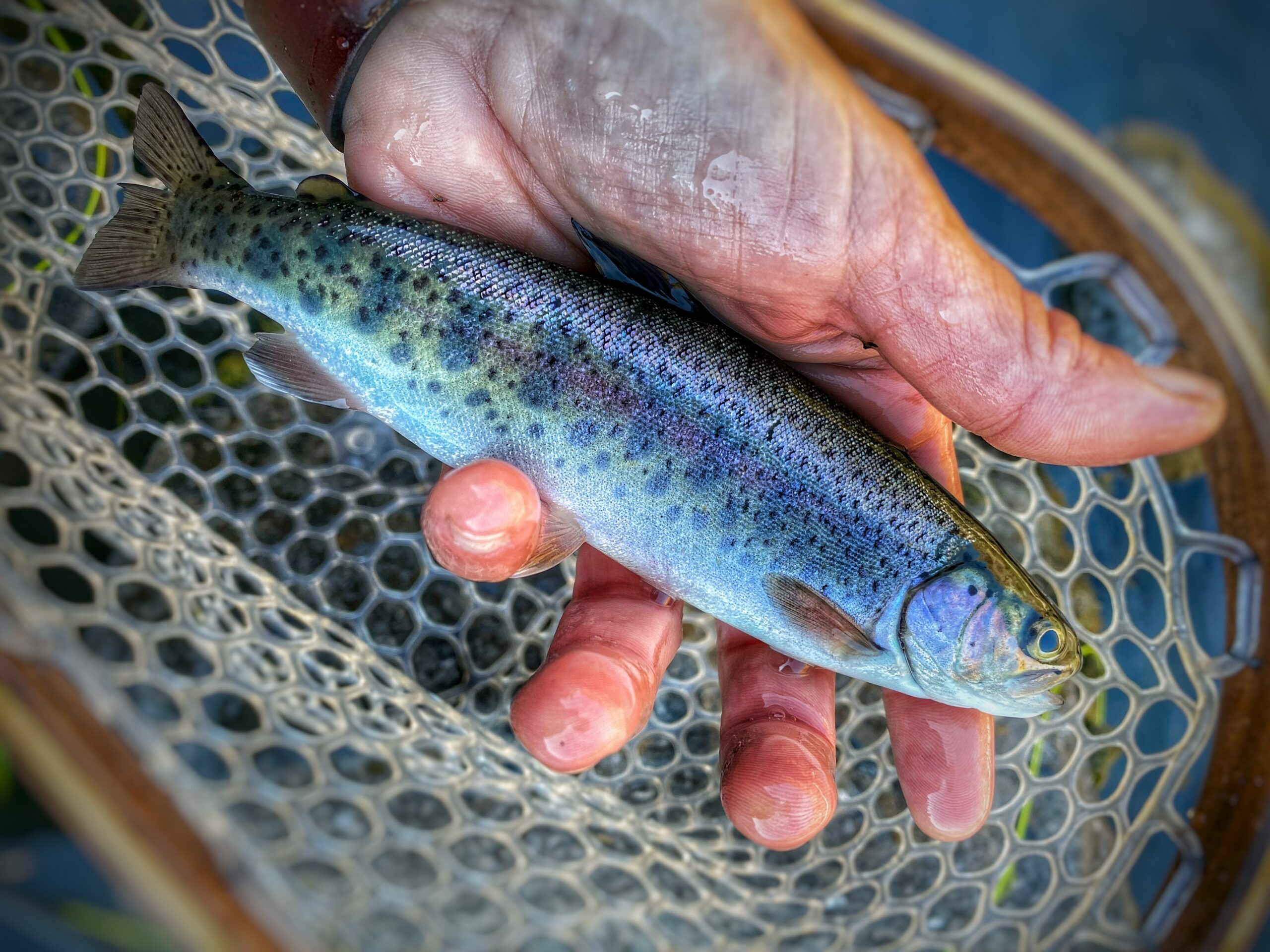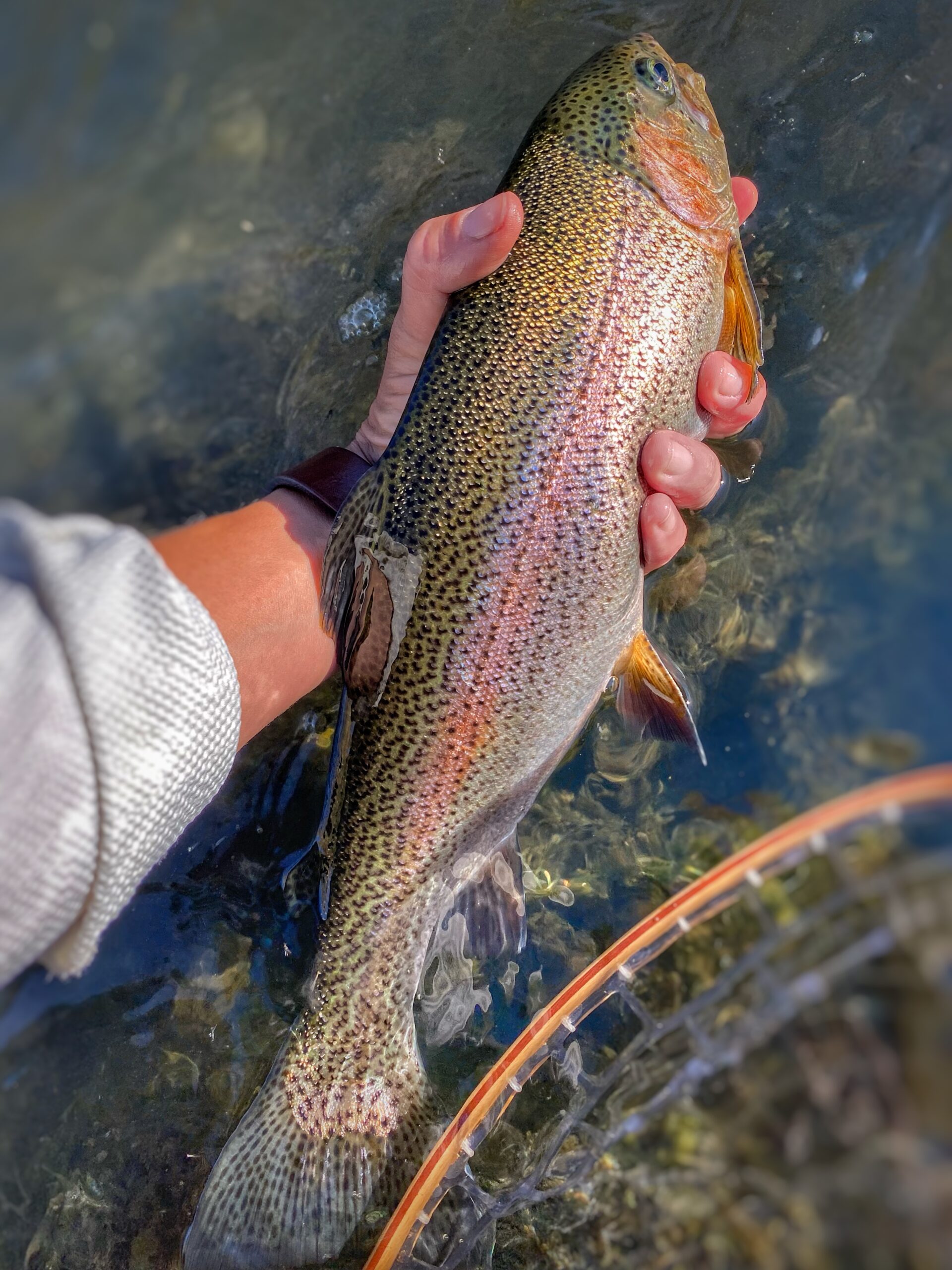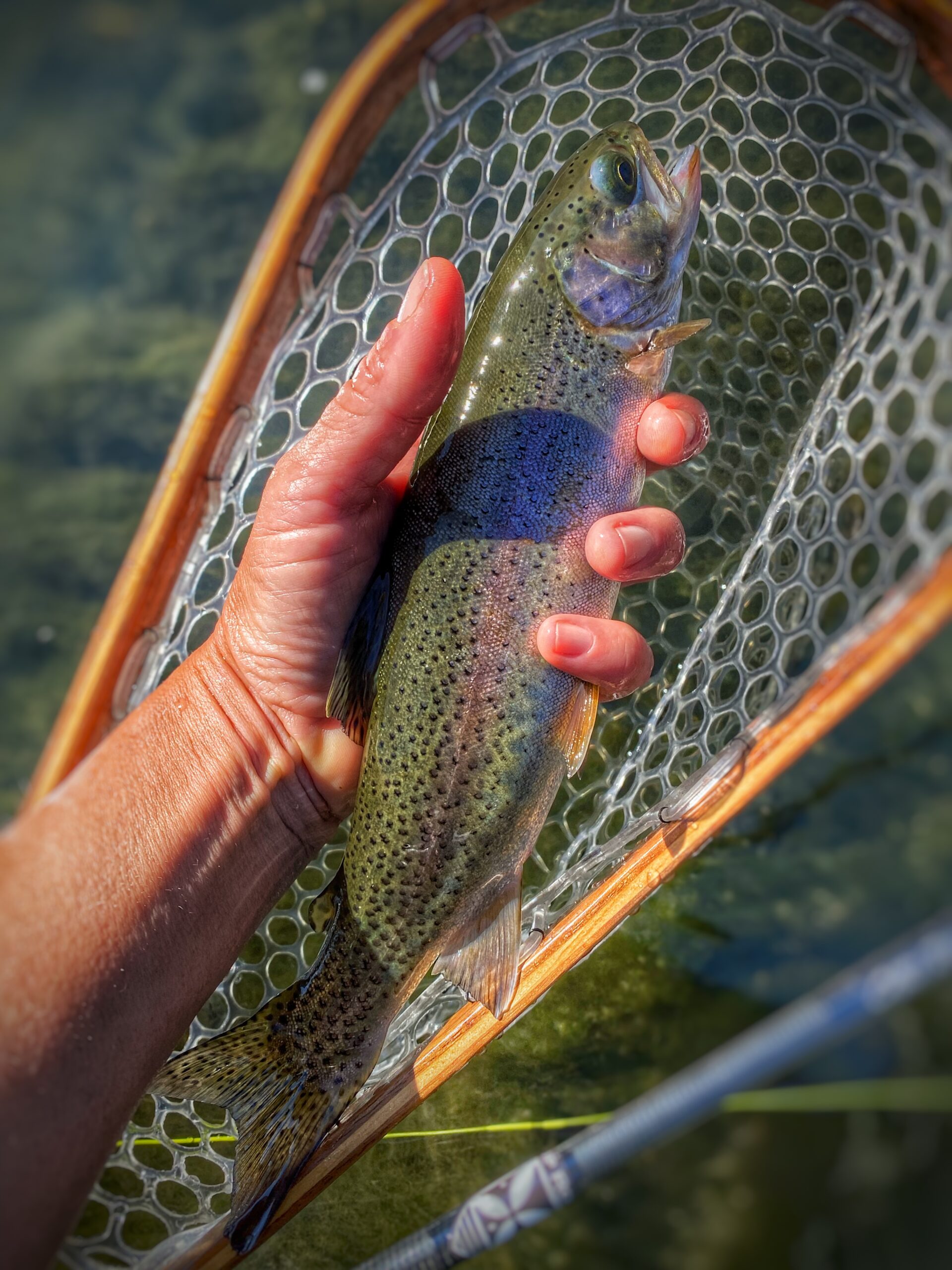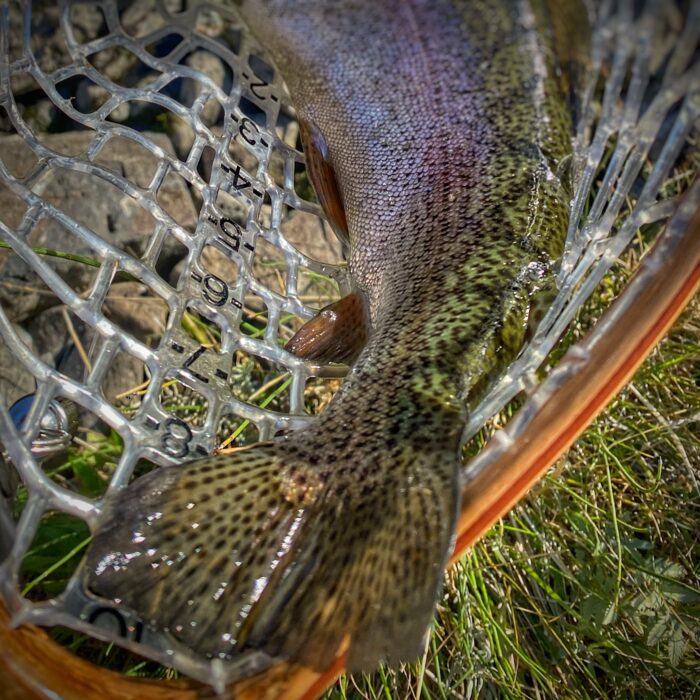In contrast to my previous month spent in Southwestern Colorado crawling around the San Juan Mountains, my pursuit of trout this time was not taking me to steep, jagged mountain gulches under the watchful gaze of the pines, but to the gently falling, flattish floor of a mesa-capped canyon bathed in the warm glow of day’s first and last light bouncing off rusty walls.

There is no better angling experience, in my estimation, than chasing native fish in their home waters. On the fly. Especially if that means heading into the backcountry. And while Colorado, opened up like an oyster offering her pearl, Central Oregon is playing it a little closer to the vest. It hasn’t helped matters that this trip to the Beaver State was completely unexpected, offering virtually no time for research. Thankfully, the week or so of family business needing my attention gave me some time to dig around. A trip to a fly shop or two. A call to yet another.
Though helpful, that information is usually just a place to start for my kind of fishing, as shops and guides are keen to point you to the well-known, popular spots where success is as close to a given as it ever gets in fly fishing. Stands to reason, as most destination anglers and tourists come to fish those very places. By contrast, they are loath not only to share specific honey holes but often even out-of-the-way creeks and tributaries. I don’t blame them, mind you. These secret spots are either their living or the sacred waters where, on a rare day off, they chase their own bliss. In their position, I wouldn’t cast my pearls either. This simply amounts to me working a little harder and enduring a little more trial and error to find what I’m looking for. I don’t mind. I’m far more interested in the rare beauty than the sure thing.
One of the reasons I chose this particular area is that it’s not nearly as well known as the top waters in these parts. And though I wouldn’t say I was disappointed, it’s fair to say I was rather unpleasantly surprised by the number of fly fishers I encountered along the river en route to my campsite. Some in the river, and some at a few of the many roadside pull-offs that skirted its banks, suiting up or peeling out of boots and waders as they perched on the tailgate of a truck or under the back hatch of an SUV. I should have suspected as much. This area is easily accessible by vehicle. And while it was a hidden gem not so many years ago, too many fly fishers with flapping gums have increased its notoriety and, as a result, the fishing pressure. That’s why the majority of my favorite spots require a bit more effort to reach…like a challenging and/or long hike.
But I had driven 3 hours, the length of my shadow had grown to nearly 3 times my height, and there were fish to be fooled. So I pulled the #CariVan into a site with a view of the water and donned my armor. I prefer to wet-wade whenever possible, but the low temperature of the water as fall approaches coupled with a rather insistent wind barreling down the canyon meant hip-waders. And the vegetation on the freestone bottom called for proper felt-soled boots as I find it easier to sneak up on fish if I can remain standing. I also decided on lining my custom 3-weight Peacemaker Sidekick fly rod by JP Ross up one weight for the added mass to aid in overcoming my nearly constant, gusty companion.

The area near camp was a little too “people-y,” so I hiked around the bend until I was well upriver from the swarm of other fly fishers. Okay, it was truly just a few, but I’ve become rather accustomed to having the waters I fish all to myself, so any number higher than zero is a little jarring when my outings almost always have me fishing for solitude as much as fish. No other anglers? Great. No footprints? Even better. In this case, the well-trodden path lead to a ridge sitting a rocky 20 feet above the flow that turned out to be a great spot for spying. I spent maybe a quarter of an hour surveying the stretch of water. I watched Redband Trout of different sizes bolt from the depths to slurp insects on the surface in waves just behind a particular diagonal rock bar only to flash me as they turned back toward the depths. Fortunately, a flicker of sun in my eyes courtesy of a waving pine pulled me from the ensuing trance in time to remember I was there to fish.
That’s something I always do. I suppose it’s just another way fly fishing helps me practice patience. As tempting as it can be to walk right up to, or into the water and start casting (I do love to cast), it’s so valuable to approach the river deliberately and with care. I think of it like recon, and believe the “scouting” is just as important as any other fishing technique I might employ on a given outing. Not only is it a great opportunity to read the water, to see where fish are or might be holding and what they might be eating, but it’s also a surefire way to see that you are present and grounded. In technical situations, it can be tempting to let the sport overshadow the zen, and grounding myself does much to help me set my mind right.
There’s a reason why trout anglers can often be seen wearing fishing vests or carrying bags bulging with nearly everything but the kitchen sink as they head to the river. Especially if it is a remote stream or waters unknown to them. For all of the preparation, one can just never be sure what might be lurking in those waters nor what it might take to coax it to the surface. And if you’re anything like me, you won’t be satisfied until you find out for yourself.

I had been told that this river was home to primarily 8-10” wild Columbia River Redband Trout with no mention of larger specimens. Fine by me, I’ll take sub-10-inch wild fish over stocked trophy trout any day. But I could swear I had seen a few flashes that pushed beyond the 12-inch mark rising. Large or small, I was determined to bring one to hand. For nearly an hour I drifted several dry flies of varying patterns and sizes. And while the fish were gorging on topwater bugs, they were not buying what I was selling. I had heard that this fishery got just enough pressure to produce picky eaters and that was bearing out to be true. I remained unsuccessful but equally undeterred. So while dries are my jam, I’m not too proud to change tactics when necessary. And necessity was dictating just that. After all, I hadn’t come halfway across the country not to get up close and personal with a wild, native trout.
It was time to call in the cavalry, also known as the nymph, a tiny sinking fly that mimics fly larva drifting in the current. Dropper style in this case, a method that dangles it a prescribed distance below a floating fly employed as a sort of “bobber.” There are fly anglers among our ranks that would have my membership card for referring to it as such. Just kidding—about the existence of a card, not the reaction of some anglers. Ah, but I digress. If fish won’t rise to a dry fly, the right pattern of nymph dangled in front of a trout’s nose is practically irresistible. It takes much less energy, and a lower risk of predation from above for a fish to make a small move underwater to put itself in the path of this tiny morsel than to rise to the surface for a bite.
I didn’t worry too much about the top indicator fly (the bobber) as I had been striking out on the surface anyhow. So I picked a high-floating foam parachute jobbie with that little bead-headed nymph trailing a couple of feet behind on some 6x tippet. For those uninitiated, 6x can handle about 4 pounds of pressure before breaking. The lighter the tippet, the harder for the fish to see and the less likely it will interfere with a natural-looking drift. And while line that light also amounts to more fish broken off in a fight, on swimmers in the 10-inch range, that would be plenty of muscle. For good measure and a fresh start, I thrashed my way 20 steps or so through the dry bankside thistle I had been playing tug of war with for the previous 60 minutes and found a solid spot make a cast. I was standing on the deeper side of the river and surrounded by bramble, so keeping my feet planted on terra firma and reaching out over the water to cast parallel to the flow was the only truly viable option.
In a moment of respite from the otherwise constant headwind, I made a few false casts and placed the fly just behind the rocky bar above the deeper part of the run where it cut into the bank at my feet. After about 5 feet of drift, the top fly disappeared below the surface. It was either a take or the nymph catching on one of the moss-covered rocks below. In such a situation, I always assume the former and attempt a hook set. Sometimes, that amounts to a nymph up my nose or hook in my ear. But better safe than skunked.
This time, that gamble paid off. Though I was still a few minutes away from appreciating just how big the payday was going to be. At first, I assumed I had hooked a rock. Until the rock took off. Whatever it was that had taken that lower fly headed quickly and convincingly into the deeper water behind a large submerged boulder. Were there carp in here? Please, dear Lord, not a carp. On a 3-weight. No matter the species, it was no small fry to be stripped in like most of the creek trout I stalk. I kept steady pressure as I read the deep flex in my rod and force against my hand to inform the alternating tug and slip of line to avoid breaking off as I played the fish and reeled up the rest of the slack behind my line hand to put my new-ish Ross Colorado Reel on the job as well. I had yet to hear it sing, but that was about to change. After a few runs had it ringing delightfully in my ears, I was finally able to apply enough pressure to bring the beast to the surface. And when I did, my brain had trouble making the math work as my eyes took in well over 20 inches of writhing, fat greenback. No matter, there was little time for calculation as, at the sight of a silvery, nearly blinding flash, my pulse again quickened and the dance began again.
What followed was an hour, okay maybe 15 minutes, of reel-palming, drag-singing, awe-inspiring run after run mixed with a dash of panic at the realization that I was carrying a little net made for little fish. Being outgunned not only in the rod department but also in the net department meant slogging into the river with this darling would be my only shot at a snowball’s chance of a landing. A chain is only as strong as its weakest link, and 6x tippet is an awfully thin thread to hang by. Had anyone else been on hand, they would have been treated to quite the show. I think watching me attempt, and finally, succeed in landing this specimen solo on ultralight and undersized gear would’ve been akin to having a ringside seat—at the circus. You’re simultaneously trying to keep enough pressure on the fish to land it without applying so much that the line snaps, deciding if it’s time to bring it to the net or let it run, and finally fumbling for your net with your line hand as you try to keep leverage with your rapidly tiring rod hand. All while sloshing and stumbling along a minefield of slippery stones glancing down frantically now and then as you try to avoid busting your ass and filling your waders with 45-degree water. Yes, it must have been quite the spectacle. As luck would have it, there were no witnesses, as I’m sure our encounter looked even more chaotic and ridiculous than it sounds.
Ultimately, I was able to walk up the bank to a narrow, underwater shelf along the edge of the pool and make a few short steps into the water where crouching down to meet my dance partner was possible. It truly was anyone’s game until netted. Honestly, given the inadequate size of the net, I’m not sure it was ever really a done deal. The moment a catch lands in the bottom of a fly angler’s net is typically accompanied by a sigh of relief—especially when there’s a trophy fish on the line. Turns out that only holds true when that net is appropriately sized. As I stretched and swirled my little creek net under the water attempting to bring this leviathan to hand, the relative scale reference provided by the tiny hoop had my head shaking again in disbelief.
But my noggin wasn’t the only thing shaking. My hands were anything but steady, from adrenaline as much as fatigue, as I made the final, triumphant scoop. My best hope was to land the heavier front end of the fish, lift and pray. But the dance was far from over. Trout, who make their life swimming against the current, are nearly all muscle and extraordinarily strong pound for pound. It was one thing to get the fish (or most of it anyway) into the net, but an entirely different thing to keep it there. But against all odds, quickly and somewhat clumsily, I grabbed my camera, lifted the fish with a sorely inadequate single hand, and returned it to the depths from whence it came. What a catch. What a day.

Hiking out, I passed a couple of other fly anglers on the trail. My answer to the “any luck?” greeting common of our lot was “Let’s just say you’re gonna need a bigger net.” After talking to a few of them who frequent the area, I was able to confirm that a fish like this mighty native Redband is the rare exception here. In fact, a couple of locals I spoke with weren’t even aware that fish that size were resident in this stretch of river. That reassurance, combined with the low water temperature and feisty release, eased my conscience a little about a fight that lasted longer than I would have preferred. To be clear, I would never intentionally target fish this size with a 3wt rod.
Throughout the flow of this life, especially when embarking on new pursuits, I’d wager that I have allowed others to shape my expectations too readily and far too often. When uncertain, I have noticed myself trusting the perceived certainty of others over my gut instincts. In those instances, I more often than not show up with low expectations—with my “small-fish net,” and play a small game. Besides, who am I to assume I can beat the handicapper’s odds?
But what’s the harm in deciding that I am the exceptional exception, that big things are in store? If I fall short, won’t my “big-fish net” make handy work of a smaller “catch?” You betcha. Mayhap it’s the angler’s equivalent to shooting for the stars and landing on the moon. But I think it’s more than that. I think that carrying a big net might just increase the odds of a big catch. Because naturally, it’s not about the net, it’s the confidence and mindset of the person who chooses to plan for success and bring it in the first place that has them poised to overcome the odds.
And with that parting thought, in a kind of reverse metamorphosis, the warm, fluttering flame of my candle lantern has been reduced to a snake of white smoke. I’m not sure if this will make any sense when I read it over coffee in the morning. But one thing is for sure. Tomorrow will be a big-net day.

For more info on Columbia River Redband Trout:
USFWS Pacific: Interior Redband Trout
Redband Trout – Western Native Trout
Columbia River redband trout – Wikipedia

